#AFRL
Explore tagged Tumblr posts
Text
DIU Teams With ARL, Space Force And Commercial Companies On Space-Based Internet
“C4ISRNET” By Courtney Albon “DIU is developing the Hybrid Space Architecture in partnership with the Space Force and the Air Force Research Laboratory to provide internet connectivity from space. The plan is to demonstrate the ability to use commercial satellites and communication systems to provide more bandwidth, security and flexibility to military and civil…

View On WordPress
#AFRL#DIU#government contracting#Government Contractors#Internet Connectivity From Space#Space Force
0 notes
Link
https://bit.ly/3LWzVPj - 🤖 The Air Force Research Laboratory (AFRL), in collaboration with The Ohio State University (OSU) and industry partners CapSen Robotics and Yaskawa Motoman, has successfully demonstrated an AI-driven autonomous robotic system, AI-FORGE, designed to enhance the manufacturing capabilities of the Department of the Air Force (DAF). The system is primed to bring transformative changes to metamorphic manufacturing or robotic blacksmithing. #AFRL #AI #ManufacturingInnovation #RoboticBlacksmithing ✈️ AI-FORGE employs incremental forming, a heat-assisted metalworking process, enabling the manufacture of small batches of custom parts for military aircraft. Its AI capabilities allow it to make crucial forming decisions independently, thus optimizing cost and time, and enhancing the ability to replace hard-to-find aircraft structural parts. #AerospaceEngineering #AIinManufacturing 💰 The project received $500,000 in funding from the Advanced Robotics for Manufacturing (ARM) Institute and $150,000 in post-doctoral research support from AFRL’s Materials and Manufacturing Directorate. It also included contributions from CapSen Robotics and Yaskawa Motoman, who provided key software and hardware components respectively. #Funding #ResearchSupport 🔬 The system underwent rigorous testing at the Warner-Robins Air Logistics Complex (WR-ALC) under challenging conditions, operating autonomously for approximately six hours without human intervention. The demonstration confirmed the system's potential to operate effectively in a depot environment. #AIinAction #FieldTest ⚙️ AI-FORGE’s operation is akin to a human metalworker using heat and pressure to forge replacement parts. The AI in this context helps automate specific portions of the forging process, from positioning and deforming a part to create desired formations. #AIAutomation #Metallurgy 🔧 The project’s next phase aims to develop a more advanced system that allows users to control the inner microstructure of the parts, especially those initially manufactured additively. This local control could transform tech development, enabling new designs and innovative material usage. #MaterialScience #FutureofManufacturing 👨⚕️ Looking ahead, the application of this technology could extend beyond aerospace. Artificially intelligent incremental forming methods could be used in the creation of personalized medical devices, such as metal implants, offering improvements in accuracy and customization. #AIinMedicine #HealthTech 🤝 The project stands as a testament to successful partnerships between AFRL, academia, industry, the ARM Institute, and the depot, highlighting the potential of collaborative efforts in bringing transformative changes in technology. #Partnerships #Collaboration 🚀 AFRL remains committed to supporting the warfighter, adapting to changes, and continually advancing its mission through innovative technologies like AI-FORGE.
#AFRL#AI#ManufacturingInnovation#RoboticBlacksmithing#AerospaceEngineering#AIinManufacturing#Funding#ResearchSupport#AIinAction#FieldTest#AIAutomation#Metallurgy#MaterialScience#FutureofManufacturing#AIinMedicine#HealthTech#Partnerships#Collaboration#Innovation
0 notes
Text
Fun fact, in 2010 the US air force pbuilt a supercomputer made out of 1,760 ps3's.
Now imagine

#ihnmaims#i have no mouth and i must scream#am ihnmaims#am i have no mouth and i must scream#allied master computer#allied mastercomputer#edit my bad it was the air force not the navy
23 notes
·
View notes
Text
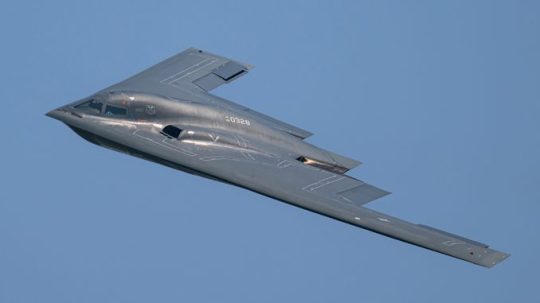
B-2 Stealth Bomber Demoes QUICKSINK Low Cost Maritime Strike Capability During RIMPAC 2024
The U.S. Air Force B-2 Spirit carried out a QUICKSINK demonstration during the second SINKEX (Sinking Exercise) of RIMPAC 2024. This marks the very first time a B-2 Spirit has been publicly reported to test this anti-ship capability.
David Cenciotti
B-2 QUICKSINK
File photo of a B-2 Spirit (Image credit: Howard German / The Aviationist)
RIMPAC 2024, the 29th in the series since 1971, sees the involvement of 29 nations, 40 surface ships, three submarines, 14 national land forces, over 150 aircraft, and 25,000 personnel. During the drills, two long-planned live-fire sinking exercises (SINKEXs) led to the sinking of two decommissioned ships: USS Dubuque (LPD 8), sunk on July 11, 2024; and the USS Tarawa (LHA 1), sunk on July 19. Both were sunk in waters 15,000 feet deep, located over 50 nautical miles off the northern coast of Kauai, Hawaii.
SINKEXs are training exercises in which decommissioned naval vessels are used as targets. These exercises allow participating forces to practice and demonstrate their capabilities in live-fire scenarios providing a unique and realistic training environment that cannot be replicated through simulations or other training methods.
RIMPAC 2024’s SINKEXs allowed units from Australia, Malaysia, the Netherlands, South Korea, and various U.S. military branches, including the Air Force, Army, and Navy, to enhance their skills and tactics as well as validate targeting, and live firing capabilities against surface ships at sea. They also helped improve the ability of partner nations to plan, communicate, and execute complex maritime operations, including precision and long-range strikes.
LRASM
During the sinking of the ex-Tarawa, a U.S. Navy F/A-18F Super Hornet deployed a Long-Range Anti-Ship Missile (LRASM). This advanced, stealthy cruise missile offers multi-service, multi-platform, and multi-mission capabilities for offensive anti-surface warfare and is currently deployed from U.S. Navy F/A-18 and U.S. Air Force B-1B aircraft.
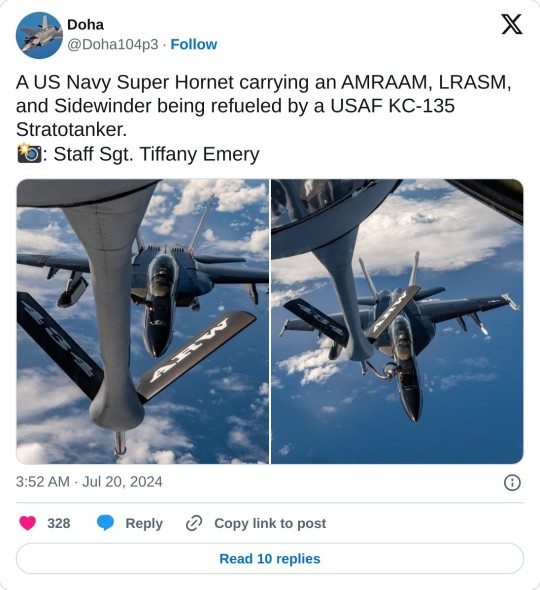
The AGM-158C LRASM, based on the AGM-158B Joint Air-to-Surface Standoff Missile – Extended Range (JASSM-ER), is the new low-observable anti-ship cruise missile developed by DARPA (Defense Advanced Research Projects Agency) for the U.S. Air Force and U.S. Navy. NAVAIR describes the weapon as a defined near-term solution for the Offensive Anti-Surface Warfare (OASuW) air-launch capability gap that will provide flexible, long-range, advanced, anti-surface capability against high-threat maritime targets.
QUICKSINK
Remarkably, in a collaborative effort with the U.S. Navy, a U.S. Air Force B-2 Spirit stealth bomber also took part in the second SINKEX, demonstrating a low-cost, air-delivered method for neutralizing surface vessels using the QUICKSINK. Funded by the Office of the Under Secretary of Defense for Research and Engineering, the QUICKSINK experiment aims to provide cost-effective solutions to quickly neutralize maritime threats over vast ocean areas, showcasing the flexibility of the joint force.
The Quicksink initiative, in collaboration with the U.S. Navy, is designed to offer innovative solutions for swiftly neutralizing stationary or moving maritime targets at a low cost, showcasing the adaptability of joint military operations for future combat scenarios. “Quicksink is distinctive as it brings new capabilities to both current and future Department of Defense weapon systems, offering combatant commanders and national leaders fresh methods to counter maritime threats,” explained Kirk Herzog, the program manager at the Air Force Research Laboratory (AFRL).
Traditionally, enemy ships are targeted using submarine-launched heavyweight torpedoes, which, while effective, come with high costs and limited deployment capabilities among naval assets. “Heavyweight torpedoes are efficient at sinking large ships but are expensive and deployed by a limited number of naval platforms,” stated Maj. Andrew Swanson, division chief of Advanced Programs at the 85th Test and Evaluation Squadron. “Quicksink provides a cost-effective and agile alternative that could be used by a majority of Air Force combat aircraft, thereby expanding the options available to combatant commanders and warfighters.”
Regarding weapon guidance, the QUICKSINK kit combines a GBU-31/B Joint Direct Attack Munition’s existing GPS-assisted inertial navigation system (INS) guidance in the tail with a new radar seeker installed on the nose combined with an IIR (Imaging Infra-Red) camera mounted in a fairing on the side. When released, the bomb uses the standard JDAM kit to glide to the target area and the seeker/camera to lock on the ship. Once lock on is achieved, the guidance system directs the bomb to detonate near the hull below the waterline.
Previous QUICKSINK demonstrations in 2021 and 2022 featured F-15E Strike Eagles deploying modified 2,000-pound GBU-31 JDAMs. This marks the very first time a B-2 Spirit has been publicly reported to test this anti-ship capability. Considering a B-2 can carry up to 16 GBU-31 JDAMs, this highlights the significant anti-surface firepower a single stealth bomber can bring to a maritime conflict scenario.
Quicksink
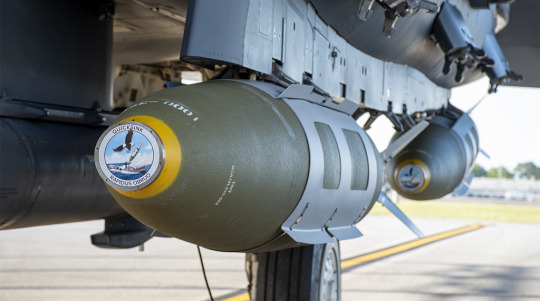
F-15E Strike Eagle at Eglin Air Force Base, Fla. with modified 2,000-pound GBU-31 Joint Direct Attack Munitions as part of the second test in the QUICKSINK Joint Capability Technology Demonstration on April 28, 2022. (U.S. Air Force photo / 1st Lt Lindsey Heflin)
SINKEXs
“Sinking exercises allow us to hone our skills, learn from one another, and gain real-world experience,” stated U.S. Navy Vice Adm. John Wade, the RIMPAC 2024 Combined Task Force Commander in a public statement. “These drills demonstrate our commitment to maintaining a safe and open Indo-Pacific region.”
Ships used in SINKEXs, known as hulks, are prepared in strict compliance with Environmental Protection Agency (EPA) regulations under a general permit the Navy holds pursuant to the Marine Protection, Research, and Sanctuaries Act. Each SINKEX requires the hulk to sink in water at least 6,000 feet deep and more than 50 nautical miles from land.
In line with EPA guidelines, before a SINKEX, the Navy thoroughly cleans the hulk, removing all materials that could harm the marine environment, including polychlorinated biphenyls (PCBs), petroleum, trash, and other hazardous materials. The cleaning process is documented and reported to the EPA before and after the SINKEX.
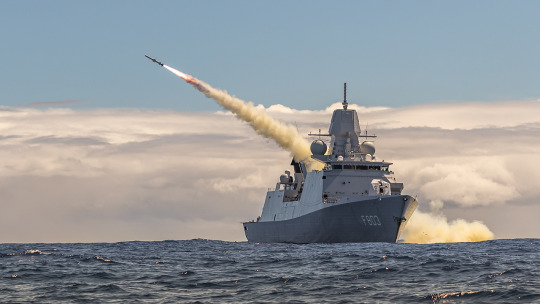
Royal Netherlands Navy De Zeven Provinciën-class frigate HNLMS Tromp (F803) fires a Harpoon missile during a long-planned live fire sinking exercise as part of Exercise Rim of the Pacific (RIMPAC) 2024. (Royal Netherlands Navy photo by Cristian Schrik)
SINKEXs are conducted only after the area is surveyed to ensure no people, marine vessels, aircraft, or marine species are present. These exercises comply with the National Environmental Policy Act and are executed following permits and authorizations under the Marine Mammal Protection Act, Endangered Species Act, and Marine Protection, Research, and Sanctuaries Act.
The ex-Dubuque, an Austin-class amphibious transport dock, was commissioned on September 1, 1967, and served in Vietnam, Operation Desert Shield, and other missions before being decommissioned in June 2011. The ex-Tarawa, the lead amphibious assault ship of its class, was commissioned on May 29, 1976, participated in numerous operations including Desert Shield and Iraqi Freedom, and was decommissioned in March 2009.
This year marks the second time a Tarawa-class ship has been used for a SINKEX, following the sinking of the ex-USS Belleau Wood (LHA 3) during RIMPAC 2006.
H/T Ryan Chan for the heads up!
About David Cenciotti
David Cenciotti is a journalist based in Rome, Italy. He is the Founder and Editor of “The Aviationist”, one of the world’s most famous and read military aviation blogs. Since 1996, he has written for major worldwide magazines, including Air Forces Monthly, Combat Aircraft, and many others, covering aviation, defense, war, industry, intelligence, crime and cyberwar. He has reported from the U.S., Europe, Australia and Syria, and flown several combat planes with different air forces. He is a former 2nd Lt. of the Italian Air Force, a private pilot and a graduate in Computer Engineering. He has written five books and contributed to many more ones.
@TheAviationist.com
12 notes
·
View notes
Note
Hi, I hope you're doing alright. I'm looking for any information regarding The Orion saucer base in Eglin AFB and what types of experiments may have been/take place there. Thank you so much
Eglin is a well known base for several UAP sightings. 1, 2, 3, 4.
One reason I have an interest in conspiracy theories is because they mostly develop from top secret projects. People, your average citizen, is unable to explain what they have just seen or heard.
Over the years documents have been released that can provide some explanation for the origin of the conspiracy theory. As someone who does research and works with facts this is the information I have found that may have led to the Orion Saucer base being Eglin.
The Eglin saucer concept considered by North American was 70 inches in diameter, nine inches deep, and was powered by two solid propellant rockets producing 10,200 pounds of thrust. An infrared tracking unit with a "jettisonable cover for initial phases of the flight . . . was installed in its nose."
Project "Pye Wacket" (great site)
The military has in the past tested flying saucer concepts. Which has also led to many theories about UFO’s.
To answer your question I would need a bit more information. The years you are looking for information about.
Eglin is a central base for numerous experiments and is also connected to Wright-Patterson in the work they do. There is AFRL at Eglin and they collaborate with many other military programmes. Some examples: DEKE DEUCE, Bamboo Eagle, Emerald Flag, the 53 Test Management Group.
Please let me know what date range, type of information you’re seeking.
Oz
8 notes
·
View notes
Photo

Sprite Fireworks
Credits: D. Sentman, U. Alaska, EXL98 Campaign, AFRL, NRL, USAFA, NASA
10 notes
·
View notes
Text
Orbital Sciences X-42 Pop-Up Upper Stage or Upper Stage Flight Experiment (USFE)

"In the 1996/1997 time frame, the U.S. Air Force began to define plans for building blocks of a future Military Spaceplane (MSP) system. The full scope of these plans came to public attention in January 1998, when the Air Force Research Laboratory (AFRL) Space Vehicles Directorate (VS) requested proposals from the industry to study various aspects of advanced military space technology. This included research related to a potential MSP system. The latter was to cover concepts for RLVs (Reusable Launch Vehicles), SMVs (Space Manoeuver Vehicles, see X-37/X-40), so-called CAVs (Common Aero Vehicles, see X-41/Falcon) and finally pop-up upper stages. Pop-up upper stages were defined as rocket stages, which could be used by RLVs or ELVs (Expendable Launch Vehicles) to boost payloads to their final orbits and/or to perform orbital manoeuvers.

Earlier, in 1997, the AFRL had already begun a formal program to develop a pop-up upper-stage, named the Modular Insertion Stage (MIS). The MIS was defined as an expendable, low-cost, liquid-fueled upper stage, which could be scaled by using one to three rocket engines (hence the 'modular' label) to suit all expected user needs. It had already been determined in AFRL-sponsored studies in 1997 by TRW and Rocketdyne, that the best-suited propellants for the requirements (storable, non-toxic fuels) would be hydrogen peroxide and kerosene. Subsequently, AFRL cooperated with NASA's Marshall Space Flight Center (MSFC) in funding and management of further development of the MIS. MSFC had its 'Bantam' low cost lift program running since 1997, and this provided a suitable contractual framework for the MIS effort. It was decided to build an MIS flight demonstrator, called Upper Stage Flight Experiment (USFE), and Orbital Sciences Corp. (OSC) was eventually awarded a contract to design and build the USFE. At some time in late 1997 or early 1998, the designation X-42A was officially allocated to an expendable demonstrator for pop-up upper-stage technology. However, this designation has so far not been further used in any official announcements, and therefore it is unclear if it will be actually applied to the USFE project (in fact, that doesn't appear too likely; see RLV section below).


Construction and component testing of the USFE prototype proceeded through mid-2003 on a relatively low-key basis. However, in that year a tank failure during a helium pressurization test completely destroyed the engine. Since then, a second prototype has been built, but propellant tank leakage problems have again delayed the program. If tests with a new tank, scheduled for early 2006, are successful, the USFE could be ready for a flight demonstration by May 2007. For this test, the USFE would be fitted as the third stage on top of a two-stage booster provided by OSC (most likely the first two stages of a retired Minuteman missile).
X-42 RLV Demonstrator
The X-42 designator has also been unofficially used by the AFRL and the industry in 2002 for a possible RLV demonstrator. Orbital Sciences Corp. (OSC) has presented a design, which is based on its Multi-Role Reusable Vehicle (MRRV) concept, a winged vehicle powered by a single RS-27 rocket engine. The significance of the use of 'X-42' for this proposal is not quite clear, but it appears to emphasize that the vehicle could be a reusable solution to the upper stage requirement.

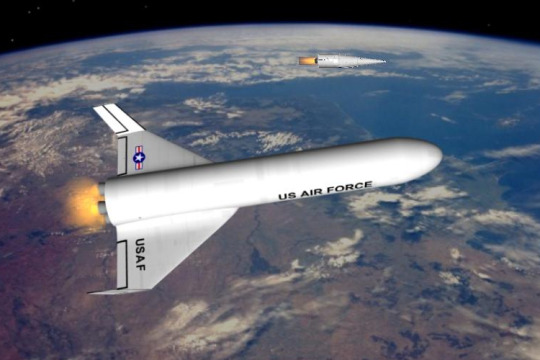
OSC X-42 RLV Demonstrator
By 2003, this design had slightly evolved, featuring a single vertical tail on the fuselage instead of the wingtip fins. A single CAV (Common Aero Vehicle) could be carried atop the fuselage and launched in space. OSC's X-42 was equipped with a conventional tricycle landing gear and a braking parachute in the aft fuselage. The vehicle was designed for versatile trajectories and short turn-around time on the ground (14 days), making it a true 'space launch workhorse'.
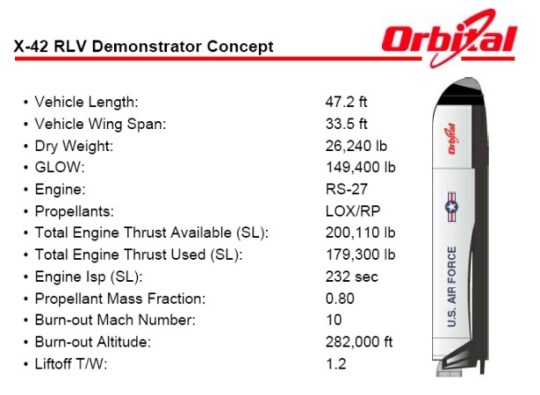
The X-42 label has also been informally used in a few papers and presentations to refer to other proposed test vehicles related to RLV and TSTO (Two Stage To Orbit) technology. The acronym RAST (Reusable Access to Space Technology) has also been mentioned together with X-42. All said, it looks as if the X-42 designation is currently not tied to a specific program or vehicle."
Information from Andreas Parsch: link
source, source
#Orbital Sciences X-42#X-42#Orbital Sciences X-42 Pop-Up Upper Stage#Pop-Up Upper Stage#x-plane#United States Air Force#U.S. Air Force#US Air Force#USAF#Department of Defense#DoD#NASA#classified#DARPA#my post
24 notes
·
View notes
Text
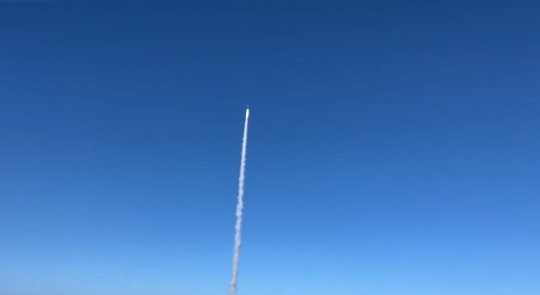
BOLT-1B hypersonic experiment soars and collects vital data
The Boundary Layer Transition 1B (BOLT-1B) experiment, a joint research project of the U.S. Air Force Research Laboratory (AFRL), the Johns Hopkins Applied Physics Laboratory (APL), and the German Aerospace Center (DLR), blasted off from Andøya Space in Norway aboard a sounding rocket on Sept. 2. The experiment traveled over the Norwegian Sea at Mach 7.2 and provided a stream of important data on the physics of airflow at hypersonic speeds.
"The data we gathered from the flight experiment will be critical for improving methods for designing future hypersonic vehicles, so we can reduce modeling uncertainties and optimize their performance," said APL's Brad Wheaton, chief scientist with the Vehicle Design and Technologies Group in APL's Force Projection Sector and the project's principal investigator.
BOLT-1B's mission is to study a phenomenon called boundary layer transition (the flow of air around the skin of a hypersonic vehicle), which increases hypersonic vehicle drag and aerodynamic heating. The scientific data collected from the test will be used by researchers to validate new and more accurate modeling and prediction methods during the design of hypersonic vehicles.
To collect this data, the experiment, designed and built by APL, was loaded with instruments to take more than 400 measurements, with locations on the vehicle determined by an extensive research effort to better understand the physics of boundary layer transition on the BOLT vehicle's geometry. As planned, the test concluded with BOLT-1B impacting the ocean approximately 185 kilometers (115 miles) offshore.
BOLT-1B is sponsored by AFRL's Air Force Office of Scientific Research. Much of the experiment's research effort on BOLT is led by APL's Force Projection Sector, with key support from the Laboratory's Air and Missile Defense and Space Exploration sectors and the Research and Exploratory Development Department. The project also includes key collaborations with international allies.
IMAGE: Launched from Norway, the BOLT-1B experiment collected data about boundary layer transition (the flow of air around the skin of a hypersonic vehicle), which increases hypersonic vehicle drag and aerodynamic heating. That data will be used by researchers to validate new and more accurate modeling and prediction methods during the design of hypersonic vehicles. Credit: Johns Hopkins APL
2 notes
·
View notes
Text
the Air Force Research Laboratory “Whimsical Dogfight Program” scrapped after repeated in-flight failures of a modified F-18 Super Hornet prototype caused by
engine combustion due to confetti blocking air intake
Nose-Mounted Red Comical Ball (NMRCB) Failure to Squeak (FTS) technical fault
Flower-Based Water Cannon for Comedic Warfighting (FBWCCW) platform catastrophic failure. Transferred from AFRL to DARPA due to restructuring of DoD’s Tactical Silliness Application Initiative (Tac-SAI)
A spokesman for the Department of Defense stated that “the US Air Force remains committed to developing and deploying Advanced Silliness Systems (ASS) in order to bring laughs and good times to defense objectives across air and space domains.” Materials provided to the press indicate the Air Force will be publicly revealing their ASS by end-of-year.
8 notes
·
View notes
Text
The Air Force Research Laboratory is using a new five-year contract with SpaceX to better understand the constraints and viability of using space launch vehicles for point-to-point cargo transport. The $102 million contract, which AFRL awarded Tuesday under its Rocket Cargo program, will give the lab more concrete data about how reusable launch vehicles could be used in future cargo missions and how the commercial capability could be adapted for use by the Department of Defense. The intent, according to program manager Greg Spanjers, is to ensure the government is ready to leverage the commercial service once industry has matured the capability.
Good to see Elon Musk staying away from warmongering defense technology, particularly those that seem to be specifically designed for a direct US war with a nuclear power in mind.
3 notes
·
View notes
Text
DVIDS - Notícias - Innovate to Accelerate Expo Day mostra inovação e colaboração espacial #ÚltimasNotícias
Hot News EL SEGUNDO, Califórnia (AFRL) – O Expo Day Innovate to Accelerate, ou I2A, realizado no coração da comunidade tecnológica de Los Angeles, reuniu mais de 260 pessoas dos setores da indústria espacial, defesa e investimento no THE BR- DGE em El Segundo, Califórnia, 17 de outubro de 2024. O evento, organizado pela SpaceWERX em parceria com a New Mexico Tech University e alimentado pelo…

View On WordPress
0 notes
Text
El DIU evalúa las operaciones de vuelo que implican drones Blue UAS y el sistema UTM.
La Unidad de Innovación en Defensa (DIU), en colaboración con el Laboratorio de Investigación de la Fuerza Aérea (AFRL) y diversas empresas tecnológicas, ha llevado a cabo recientemente una serie de importantes operaciones de vuelo con el objetivo de presentar un nuevo sistema para gestionar el tráfico de drones. Este evento, que tuvo lugar durante tres días en el sitio de pruebas de UAS de Nueva…
0 notes
Text
Exploring the Capabilities of Custom Reconnaissance Drones
Exploring the Capabilities of Custom Reconnaissance Drones In the world of unmanned aerial vehicles (UAVs), custom reconnaissance drones are making a significant impact. These drones, designed for specific surveillance and reconnaissance missions, are transforming the way we gather and analyze information.Get more news about Custom Reconnaissance Drone,you can vist our website!
A prime example of a custom reconnaissance drone is the Unmanned Long-endurance Tactical Reconnaissance Aircraft (ULTRA). Developed by the Air Force Research Laboratory (AFRL) Center for Rapid Innovation (CRI) and DZYNE Technologies Incorporated, ULTRA is a testament to the potential of custom drones.
ULTRA is designed to be an Intelligence, Surveillance, and Reconnaissance (ISR) truck capable of carrying a variety of electro-optical/infrared (EO/IR) and radiofrequency (RF) sensors. This reconfigurable platform can adapt to different mission requirements, making it a versatile tool in the field.
The drone utilizes a novel approach to achieve long endurance and acquisition cost objectives. It repurposes a previously manned commercial sport glider and converts it to a military hardened unmanned air vehicle. This innovative approach ensures acquisition and sustainment costs remain low.
ULTRA’s endurance capability is impressive. It can fly for over several hours while carrying a substantial payload. This long endurance allows these ISR sensors to provide unblinking coverage of areas of interest with fewer aircraft.
The drone relies on an operator-friendly command and control system that allows for “Point and Click” operations. Full global operations are possible through satellite-based command and control links that also provide the high-rate ISR data feed to the operators in real time.
In conclusion, custom reconnaissance drones like ULTRA are revolutionizing the field of surveillance and reconnaissance. Their ability to carry a variety of sensors, coupled with their long endurance and low acquisition cost, make them an invaluable asset in today’s information-driven world.
0 notes
Text

USAF B-2 bomber demonstrates ability to neutralize low-cost maritime threats
Fernando Valduga By Fernando Valduga 08/09/2024 - 16:00 in Military
0
Shares
99
Views
Share on Facebook
Share on Twitter
The U.S. Air Force (USAF) stealth bomber B-2 Spirit recently demonstrated a low-cost, air-released method to neutralize surface vessels during a QUICKSINK test in the Gulf of Mexico, near Eglin Air Base, Florida.
This capability is a response to an urgent need to quickly neutralize maritime threats in large expanses of the ocean around the world, USAF said in an official statement. No other details have been provided.
The QUICKSINK test, conducted in partnership with the U.S. Navy, involved a B-2 Spirit stealth bomber delivering the new capability as part of the second RIMPAC SINKEX exercise in July. The demonstration marks a fundamental advance in the naval warfare capabilities of the U.S. Air Force, highlighting a collaboration between the Air Force Research Laboratory (AFRL), the U.S. Navy and industry partners.

"This technology ensures that the United States can defend its interests, maintain freedom of action and take the initiative in large maritime areas," said Colonel Matthew Caspers, Director of the AFRL Ammunition Board.
The AFRL Ammunition Board, based at Eglin Air Base, is involved in an ongoing Marine Weapons Program together with the U.S. Navy.
The tests take place amid the increase in Iran-backed Houthi attacks on commercial ships in the Red Sea. The U.S. Defense Intelligence Agency (DIA) reported that from December 2023 to mid-February 2024, container transport in the region decreased by 90%. Despite U.S. and European countermeasures, including Operation Prosperity Guardian and the European Union's ASPIDES mission, the Houthis carried out more than 43 attacks between November 19 and March 23, resulting in increased security costs and insurance premiums.
Tags: AFRLMilitary AviationB-2 SpiritUSAF - United States Air Force / U.S. Air Force
Sharing
tweet
Fernando Valduga
Fernando Valduga
Aviation photographer and pilot since 1992, he has participated in several events and air operations, such as Cruzex, AirVenture, Dayton Airshow and FIDAE. He has works published in specialized aviation magazines in Brazil and abroad. He uses Canon equipment during his photographic work in the world of aviation.
Related news
HELICOPTERS
Iraq orders Airbus H225M Caracal helicopters and also receives new Bell 505
09/08/2024 - 14:00
MILITARY
Greece seeks to acquire Boeing KC-135R Stratotanker aircraft from the USA
09/08/2024 - 09:30
MILITARY
Brazil proposes KC-390 aircraft for India and considers buying Brahmos and Akash missiles
09/08/2024 - 08:27
BRAZILIAN AIR FORCE
FAB intensifies aerial monitoring and intercepts more than 4,000 aircraft in 5 years
08/08/2024 - 20:50
MILITARY
South Korea would be offering FA-50 jets for Bulgaria's defense
08/08/2024 - 16:00
MILITARY
U.S. Army studies launching wandering ammunition from C-130 Hercules aircraft
08/08/2024 - 14:00
9 notes
·
View notes
Photo

Раскрыты новые факты о секретном дроне нового поколения от DARPA
Показываем, как выглядит прототип XRQ-73, и рассказываем все, что о нем известно.
В сети появилась фотография нового американского беспилотного летательного аппарата X-plane серии Hybrid Electric Propulsion AiRcraft Demonstration (SHEPARD). Он получил название XRQ-73. Разработка создана по заказу Управления перспективных исследовательских проектов Министерства обороны США (DARPA). Стало известно, что дрон поднимется в воздух к концу 2024 года, пишет New Atlas.
БПЛА на фото — это демонстрационный прототип, произведенный военно-промышленной компанией Northrop Grumman и авиастроительной компанией Scaled Composites. Конструкция летающего крыла основана на разработках исследовательской лаборатории ВВС (AFRL) Great Horned Owl (GHO), программы IARPA (Intelligence Advanced Research Projects), в рамках которой использовалась смешанная конструкция крыла и внешние воздуховодные толкающие винты.
Дрон большой, но малозаметный. Размах крыла составляет более 30 футов (9 м), при этом весит летательный аппарат 1250 фунтов (567 кг) и может развивать скорость 250 узлов (287 миль/ч, 463 км/ч). Он предназначен для полетов на высоте 18 000 футов (5500 м) с полезной нагрузкой 400 фунтов (180 кг).
Ни DARPA, ни Northrop Grumman не разглашают технические характеристики своей новой разработки. Но по фото можно сказать, что беспилотник имеет широкую, сужающуюся форму, которая заканчивается обрезанными концами крыла.
Подробнее https://7ooo.ru/group/2024/07/12/044-raskryty-novye-fakty-o-sekretnom-drone-novogo-pokoleniya-ot-darpa-grss-323596620.html
0 notes
Text
DARPA'nın son hayalet drone'u X-plane'in ilk fotoğrafı

Northrop Grumman , DARPA için ürettiği ve yıl sonuna kadar uçması beklenen Seri Hibrit Elektrikli Motorlu Uçak (SHEPARD) XRQ-73 hayalet drone X-plane'in bir fotoğrafını yayınladı . DARPA'nın X-Prime programının bir parçası olan XRQ-73A, Northrop Grumman ve Scaled Composites tarafından oluşturulmuş bir gösteri prototipidir. Uçan kanat tasarımı, karma kanat tasarımı ve harici kanallı itme pervaneleri kullanan, Gelişmiş İstihbarat Araştırma Projeleri Faaliyeti (IARPA) programı olan Hava Kuvvetleri Araştırma Laboratuvarı (AFRL) Büyük Boynuzlu Baykuş'a (GHO) dayanmaktadır. Buna karşılık XRQ-73A daha büyük ve daha gizlidir. 30 ft'nin (9 m) çok üzerinde bir kanat açıklığına sahip olup, 1.250 lb (567 kg) ağırlığındadır ve 18.000 ft (5.500 m) yükseklikte 250 kn (287 mph, 463 km/h) hıza ulaşabilir. 400 lb (180 kg) taşıma kapasitesi. Ne DARPA ne de Northrop Grumman, araçla ilgili pek fazla ayrıntı yayınlamadı ancak son fotoğraf, havacılık mühendislerine yorum yapabilecekleri bazı ipuçları veriyor. Kırpılmış kanat uçlarıyla biten geniş, sivrilen bir şekle sahiptir. Dört kanallı fandan oluşan hibrit elektrikli tahrik sistemi, kanat/gövdenin içine yerleştirilmiştir ve iki elektrik jeneratörü dizel, benzin veya havacılık yakıtıyla çalıştırılır. Ayrıca önde iki büyük hava girişi ve arkada çıkışlar bulunmaktadır. Bunlar görsel ve radar profillerini minimuma indirecek şekilde şekillendirilmiştir. Bir jet olmadığı için ısı imzası muhtemelen aynı derecede küçüktür. Bir diğer nokta ise hava girişleri arasındaki kaportadaki iki küçük deliktir. Bunlar muhtemelen sensörler veya diğer yükler için montaj yerleridir. GHO gibi XRQ-73A'nın da uzun uçuş süreleri için hem gizlilik hem de dayanıklılık gerektiren ultra sessiz, yüksek verimli bir keşif uçağı olması amaçlanıyor. Read the full article
0 notes